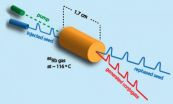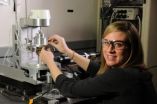(Press-News.org) Athens, Ga. – Low oxygen levels in cells may be a primary cause of uncontrollable tumor growth in some cancers, according to a new University of Georgia study. The authors' findings run counter to widely accepted beliefs that genetic mutations are responsible for cancer growth.
If hypoxia, or low oxygen levels in cells, is proven to be a key driver of certain types of cancer, treatment plans for curing the malignant growth could change in significant ways, said Ying Xu, Regents-Georgia Research Alliance Eminent Scholar and professor of bioinformatics and computational biology in the Franklin College of Arts and Sciences.
The research team analyzed samples of messenger RNA data—also called transcriptomic data—from seven different cancer types in a publicly available database. They found that long-term lack of oxygen in cells may be a key driver of cancer growth. The study was published in the early online edition of the Journal of Molecular Cell Biology.
Previous studies have linked low oxygen levels in cells as a contributing factor in cancer development, but not as the driving force for cancer growth. High incidence rates of cancer around the world cannot be explained by chance genetic mutations alone, Xu said. He added that bioinformatics, which melds biology and computational science, has allowed researchers to see cancer in a new light. Gene-level mutations may give cancer cells a competitive edge over healthy cells, but the proposed new cancer growth model does not require the presence of common malfunctions such as a sudden proliferation of oncogenes, precursors to cancer cells.
"Cancer drugs try to get to the root—at the molecular level—of a particular mutation, but the cancer often bypasses it," Xu said. "So we think that possibly genetic mutations may not be the main driver of cancer."
Much of cancer research so far has focused on designing drug treatments that counteract genetic mutations associated with a particular type of cancer. In their study, the researchers analyzed data downloaded from the Stanford Microarray Database via a software program to detect abnormal gene expression patterns in seven cancers: breast, kidney, liver, lung, ovary, pancreatic and stomach. The online database allows scientists to examine information from microarray chips, which are small glass slides containing large amounts of gene material.
Xu relied on the gene HIF1A as a biomarker of the amount of molecular oxygen in a cell. All seven cancers showed increasing amounts of HIF1A, indicating decreasing oxygen levels in the cancer cells.
Low oxygen levels in a cell interrupt the activity of oxidative phosphorylation, a term for the highly efficient way that cells normally use to convert food to energy. As oxygen decreases, the cells switch to glycolysis to produce their energy units, called ATP. Glycolysis is a drastically less efficient way to obtain energy, and so the cancer cells must work even harder to obtain even more food, specifically glucose, to survive. When oxygen levels dip dangerously low, angiogenesis, or the process of creating new blood vessels, begins. The new blood vessels provide fresh oxygen, thus improving oxygen levels in the cell and tumor and slowing the cancer growth—but only temporarily.
"When a cancer cell gets more food, it grows; this makes the tumor biomass bigger and even more hypoxic. In turn, the energy-conversion efficiency goes further down, making the cells even more hungry and triggering the cells to get more food from blood circulation, creating a vicious cycle. This could be a key driver of cancer," Xu said.
Xu explained that this new cancer-growth model could help explain why many cancers become drug resistant so quickly—often within three to six months. He stressed the importance of testing the new model through future experimental cancer research. If the model holds, researchers will need to search for methods to prevent hypoxia in cells in the first place, which could result in a sea change in cancer treatment.
###Additional authors of this study include Juan Cui, Xizeng Mao and Victor Olman, all of UGA, and Phil Hastings of Baylor College of Medicine. Xu also has a joint appointment with Jilin University in China.
Low oxygen levels could drive cancer growth
2012-05-04
ELSE PRESS RELEASES FROM THIS DATE:
Southwest Solutions Group Selected Key Field Service Operations for KardexRemstar Products
2012-05-04
Southwest Solutions Group has been selected as a key field sales and service organization for KardexRemstar products. Services include layout and design, installation, relocations, parts, and routine service and preventative maintenance agreements for KardexRemstar products. Products include Vertical Lift Modules (VLM), Vertical Storage and Retrieval Carousels (VSR), and Lektriever Series 80, 90, 2000 electric filing cabinets throughout the states of Texas, Oklahoma, Arkansas, Louisiana, and Mississippi. "As a full service KardexRemstar Dealer, we are pleased that ...
New protocol enables wireless and secure biometric acquisition with web services
2012-05-04
Researchers at the National Institute of Standards and Technology (NIST) have developed and published a new protocol for communicating with biometric sensors over wired and wireless networks—using some of the same technologies that underpin the web.
The new protocol, called WS-Biometric Devices (WS-BD), allows desktops, laptops, tablets and smartphones to access sensors that capture biometric data such as fingerprints, iris images and face images using web services. Web services themselves are not new; for example, video-on-demand services use web services to stream videos ...
First light: NIST researchers develop new way to generate superluminal pulses
2012-05-04
Researchers at the National Institute of Standards and Technology (NIST) have developed a novel way of producing light pulses that are "superluminal"—in some sense they travel faster than the speed of light.* The technique, called four-wave mixing, reshapes parts of light pulses and advances them ahead of where they would have been had they been left to travel unaltered through a vacuum. The new method could be used to improve the timing of communications signals and to investigate the propagation of quantum correlations.
According to Einstein's special theory of relativity, ...
Fabrication method can affect the use of block copolymer thin films
2012-05-04
A new study by a team including scientists from the National Institute of Standards and Technology (NIST) indicates that thin polymer films can have different properties depending on the method by which they are made. The results* suggest that deeper work is necessary to explore the best way of creating these films, which are used in applications ranging from high-tech mirrors to computer memory devices.
Thin films spread atop a surface have many applications in industry. Inexpensive organic solar cells might be made of such films, to name one potential use. Typically ...
Science nugget: Lightning signature could help reveal the solar system's origins
2012-05-04
Every second, lightning flashes some 50 times on Earth. Together these discharges coalesce and get stronger, creating electromagnetic waves circling around Earth, to create a beating pulse between the ground and the lower ionosphere, about 60 miles up in the atmosphere. This electromagnetic signature, known as Schumann Resonance, had only been observed from Earth's surface until, in 2011, scientists discovered they could also detect it using NASA's Vector Electric Field Instrument (VEFI) aboard the U.S. Air Force's Communications/Navigation Outage Forecast System (C/NOFS) ...
Ultrasound idea: Prototype NIST/CU bioreactor evaluates engineered tissue while creating it
2012-05-04
Researchers at the National Institute of Standards and Technology (NIST) have developed a prototype bioreactor—a device for culturing cells to create engineered tissues—that both stimulates and evaluates tissue as it grows, mimicking natural processes while eliminating the need to stop periodically to cut up samples for analysis. Tissue created this way might someday be used to replace, for example, damaged or diseased cartilage in the knee and hip.
Conventional methods for evaluating the development and properties of engineered tissue are time-consuming, destructive ...
Prompt Proofing Blog Post: Revisiting Homophones 3
2012-05-04
In this month's grammar post we are taking another look at some frequently confused homophones. All of the homophones below have been recently spotted, used erroneously, in business communications or copy!
Click here for our first homophones blog post, and here for our second.
insure / ensure
You only insure something in the legal sense - dealing with an insurance company. If you want to make sure something happens you will ensure it. Hence: You insure your car to ensure you will not lose out financially if it is stolen or damaged.
precede / proceed
If something ...
Study examines necessity of additional imaging in PET/CT oncologic reports
2012-05-04
Radiologists and nuclear medicine physicians recommended additional imaging about 30% of the time in oncologic PET/CT reports, with about half of those recommendations being unnecessary, a new study shows.
The study, conducted at Brigham and Women's Hospital in Boston, included 250 patients. The study found that there were 84 recommendations made for additional imaging. When study reviewers examined the patients' records, they concluded that 43 of those recommendations were unnecessary, said Atul Shinagare, MD, one of the authors of the study. No adverse patient outcome ...
6 month follow-up of patients with benign MRI-guided breast biopsies may not be necessary
2012-05-04
Short term follow-up of patients who have had a negative (benign) MRI-guided vacuum assisted breast biopsy may not be necessary, a new study indicates.
The study, conducted at Yale New Haven Hospital in Connecticut, included 144 patients with 176 lesions that were followed anywhere from three months to 36 months. The study found no malignancies on follow-up MR imaging, said Jaime Geisel, MD, one of the authors of the study. Two patients had suspicious findings at follow-up and underwent a second biopsy six months after the initial biopsy; one yielded benign results and ...
Preop MRI valuable in detecting additional malignancies in dense & not dense breasts
2012-05-04
Newly diagnosed breast cancer patients should undergo a preoperative MRI exam even if their breasts are not dense, a new study indicates. The study found no difference between the usefulness of 3T breast MRI in detecting additional malignancies and high risk lesions in dense versus non-dense breasts.
"There are currently no guidelines that define the role of breast density in determining if a preoperative MRI should be performed. However, anecdotally, we know that preoperative MRI exams tend to be ordered more frequently in younger patients and/or patients with dense ...





